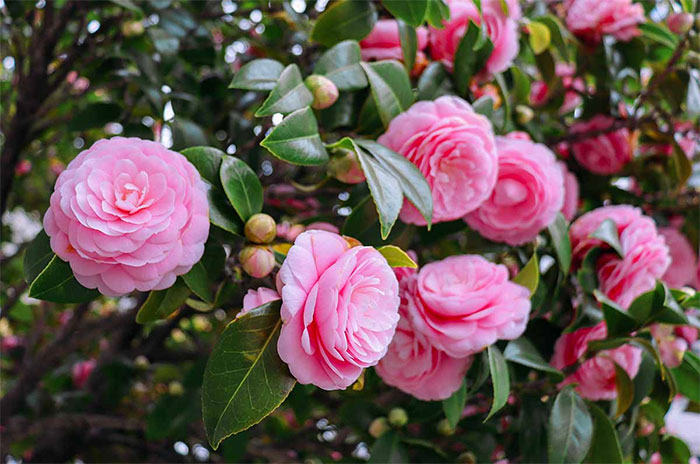Camellia Flower Symbolism Facts & Meaning: Zodiac, Superstitions, Dreams, and Legends
I
Camellia Flower Facts
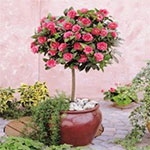
Camellia is an icon in itself. According to CHANEL, the renowned fashion designer Gabrielle “Coco” Chanel used the Camellia as one of her emblems in their designs. This has elevated the flower to icon status by the French fashion house.
Camellia japonica, also known as “Common Camellia” or “Japanese Camellia”, are flowering evergreen small trees or shrubs belonging to the tea family or the Theaceae family. Camellia cultivars with its hybrid species number in the thousands.
Flowers are 1 – 13 cm (0.4 – 5 inches) in size, can be white, cream, pink, red, purple, yellow, or variegated, and comes in a variety of shapes and sizes, including single, double, rose, and peony. Camellias have dark shiny green leaves that remain evergreen.
The plant is indigenous to Eastern and Southern Asia, specifically China, Japan, Korea, India, and Indonesia. Camellia sinensis is commonly referred to as the “tea plant” because it is the most commonly used plant in the world to make tea, typically from young leaves. It can be found in green tea, white tea, oolong tea, black tea, and many other tea products.
Camellias can grow to a height of 6 meters, depending on the species. The most popular types of Camellias are sasanqua, japonica, and reticulata.
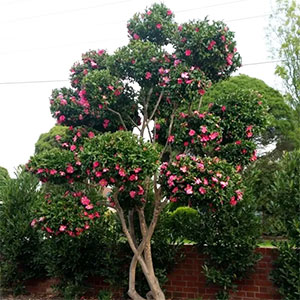
II
Camellia Flower Uses
Some plants, particularly sasanqua, can be used as hedges, topiaries, and espaliers.
Tea seed oil made from Camellia seeds is a popular and essential cooking oil, especially in southern China.
The green tea, in particular, can also be made with Camellia petals. It is rich with antioxidants known to have numerous health benefits such as lowering cholesterol, preventing heart disease, and increasing metabolism.
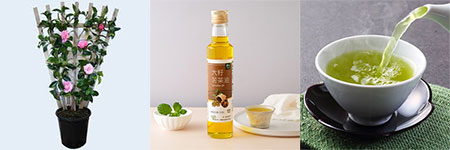
III
Camellia Flower History
Camellias have been around for about 5000 years now, thanks to accounts on medicinal data. The oldest living Camellia is located in Panlong Monastery, China. It was planted in the year 1347.
Carl Linneaus, the father of taxonomy, named the Camellia in posthumus honor after botanist Georg Kamel.
The British started cultivating Camellia for tea in 1744. Eventually, the plant was brought to America by French Botanist André Michaux in 1786. Captain Richard Rawes imported in England the first “reticulata”, thereafter was named ‘Captain Rawes’. Remains in Europe as the only known “reticulata” cultivated for over hundreds of years.
An early known published book about Camellias is the ‘Monographie du genre Camellia’ of 1837 by Father Abbé Lorenzo Berlese. It is followed by ‘Iconographie du genre Camellia’ of 1841 also by Father Berlese.
In 1959, Camellia was designated as Alabama’s state flower.
IV
Camellia Flower Positive Symbolism

For the Chinese, the Camellia represents a love bond between a man and woman. The petal is the woman and the calyx is the man. When a Camellia bloom dies, the entire bloom falls off.
But different colors can mean different things. Compared to pink Camellias, which are typically associated with desire, white Camellias have a more innocent image.
V
Camellia Flower Negative Symbolism

In most countries and cultures, Camellias, like any other flower, indicate positive symbolism.
White Camellias, however, are associated with death in Japan. White Camellias should not be sent for any other reason than funerals.
VI
Camellia Flower Cultural Symbolism
Camellia, which means “priest’s helper” in Latin, was named after the late-17th-century Jesuit botanist Georg Joseph Kamel, who practiced pharmaceutical botany. He is well-known for his work in the Philippines, where he spent more than 20 years researching new treatments derived from indigenous plants. Despite the fact that there is no evidence of Kamel working with Camellias, Carl Linnaeus named the flower after him to honor his many contributions to the world of pharmacy.
Interestingly, Camellias were used in Victorian England to send a message that the receiver is adorable. In Korea, they view it to denote faithfulness. The flower is also customarily associated with divinity which is often used in religious ceremonies in Japan.
There has been a traditional association of Camellias with the samurais. The Camellia Flowers fall from the plant quickly and completely, whereas other flowers gradually lose one petal at a time. Samurais interpret the unusual death of these flowers to a hope that the Camellia’s quick death would mirror their own.
Sacramento is colloquially known as Camellia City.
VII
Camellia Flower Zodiac Sign

Camellias are said to be connected to Libra, with the same symbolism as brave and strong.
VIII
Camellia Flower in Dreams
If you encounter a Camellia in a dream, it represents romantic rumors. You might discuss your crushes with your buddies and go into great detail about each one.
Dreaming of giving someone a Camellia means that a close friend or family member will let you down. They’ll probably say or do something that changes the way you perceive them, and you’ll stop wanting to be around them.
Receiving Camellia Flowers in a dream indicates that you will be invited to a party. It is possible that you’ll have to go see folks you don’t like. You’ll have the impression that they are scrutinizing every aspect of your behavior. You won’t be able to unwind since you’ll be continuously watching out for potential mistakes.
Planting Camellias in your dream represents difficulties in the workplace. Even though you are now putting in a lot of labor and effort, the conclusion may not be favorable.
Dreaming of watering Camellias means you should focus on your confidence. You have a lot of positive traits, but you lack self-confidence.
IX
Camellia Flower Omens and Superstitions
Tsubaki (as Japanese call Camellias) was allegedly never seen in a samurai’s garden. The reason for this is how the Camellias bloom wilts. This is one particularly negative aspect of tsubaki, at least for samurai back in the day.
While other flowers wither and gradually lose one petal at a time, the Camellia Flower falls from the plant quickly and completely. It represents the samurais hope for the same quick death while performing harakiri, a samurai ritual.
The samurai cut their stomach, and a second in command ready on his back, with a drawn sword and prepared to slash the samurai’s head. It reflects a connection with the Camellia losing its head. Therefore, these military warriors saw Camellias as symbols of bravery and strength in the face of adversity. Japanese people frequently used these flowers to commemorate fallen samurais.
X
Camellia Flower Mythology and Folklore
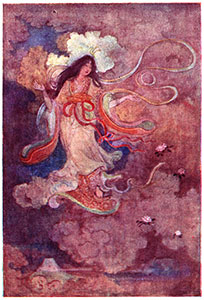
A young lad named Yosoji, as instructed by the town’s healer, went up to Mt Fuji to fetch water from the shrine on the top of the mountain. The lad’s mother was sick and the only cure was that water. Yosoji came to a place where there were 3 different paths and he didn’t know which one to choose.
A girl came out of nowhere and told him to follow her to the shrine. There, just as the healer said, was a shrine and the girl told him to drink from it and take water from it, too. She also instructed her to come back after 3 days to fetch another.
Yosoji made a few trips to the shrine. Soon after, his mother as well as the other townspeople who drank the water were cured. They thanked and celebrated Yosoji. But Yosoji felt that it was the girl that should be thanked.
So he went back to the shrine but she was no longer there. He knelt and thanked the girl from his heart and hoping that it would somehow reach her. When he stood up, he saw the girl. He asked for her name. The girl just smiled at him but didn’t reply. Instead, she reached out her hand in the air and a branch of Camellia appeared.
She waved it as a signal, then a small cloud appeared at her feet. She stepped on it and the cloud slowly moved up and disappeared. Then he realized that the girl was Sengen, the goddess of Mount Fuji. He was sad because he realized that he was not only thankful to the goddess, but that he had also learned to love her.
As he knelt again, the goddess Sengen dropped the Camellia on the ground and landed on Yosoji. Sengen then turned away, with her face blushing.

